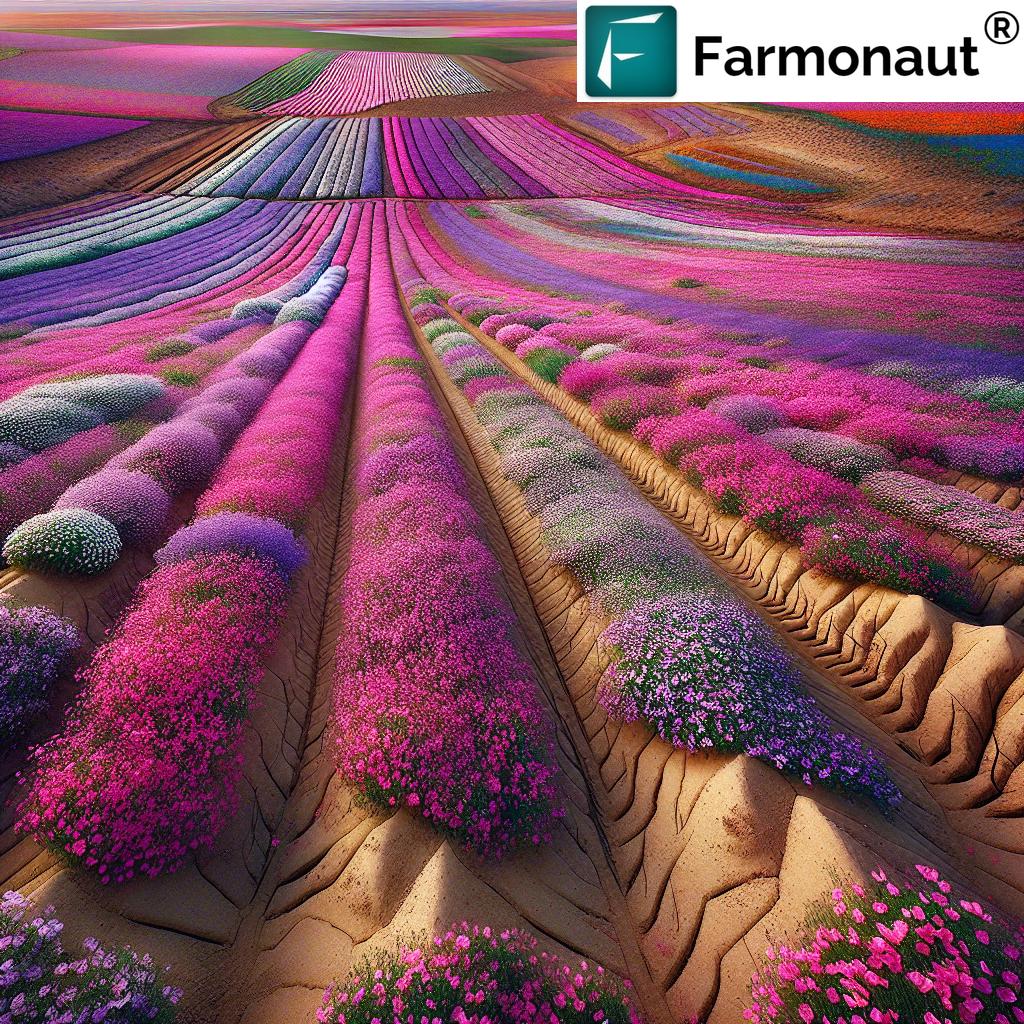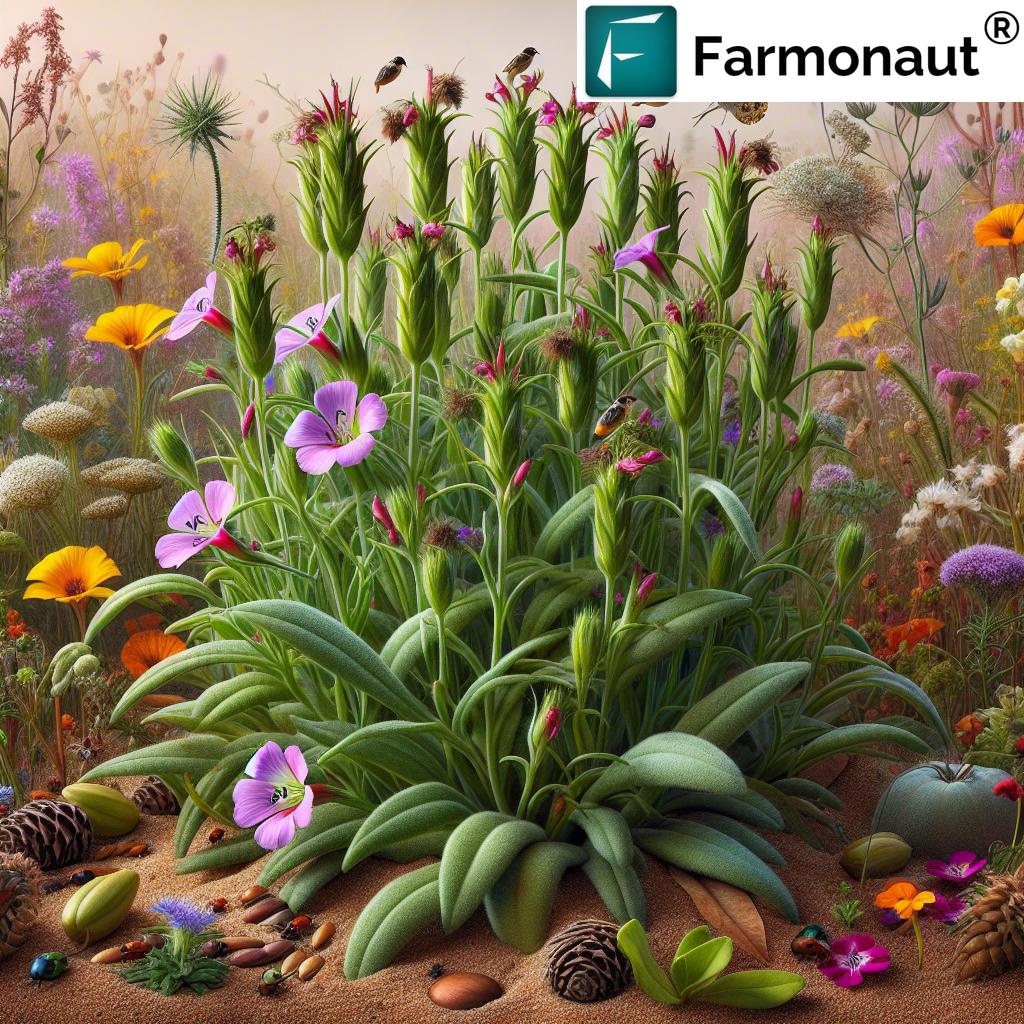Clarkia Flower: 7 Benefits for Western US Farming
“Clarkia wildflowers can boost pollinator visits by up to 40% in Western US sustainable farms.”
Introduction: Clarkia Flowers & Western US Agriculture
Clarkia, commonly known as “Farewell-to-Spring,” is a vibrant genus of annual wildflowers native to the Western United States. With their crêpe-like blossoms and adaptability, Clarkia flowers have become increasingly valued in agricultural and forestry sectors. Their resilience, diverse colors, and ecological profile make them a focal point in sustainable farming methods across California, Oregon, Washington, Nevada, and other western regions.
In this comprehensive guide, we explore the 7 key benefits of growing Clarkia wildflowers in Western US farming. We’ll unravel their agricultural significance, reveal their planting requirements, and outline the best practices for integrating this resilient wildflower into various land management strategies using sustainable farming methods.
Botanical Characteristics of Clarkia Plants
Clarkia species are distinct annual wildflowers identifiable by their upright stems ranging from 2 to 3 feet in height. Their lance-shaped leaves and slender habit make them ideal for mixing with other native flora. The flowers showcase a spectrum of colors—from pale pinks and lavenders to vivid reds—often with deeper splotches at the petal bases.
Blooming predominantly during late spring and early summer (June–July), Clarkia thrives in well-drained environments and full sunlight. The genus is celebrated as one of the most adaptable annual wildflowers for agriculture in the western United States. These wildflowers are perfect as border plants, meadow accents, or for incorporation into ecological restoration projects.
Key Botanical Aspects of Clarkia wildflowers
- Genus: Clarkia
- Growth Habit: Annual, upright stems, 2–3 feet tall
- Leaves: Lanceolate, mid-green
- Blooms: Crêpe-textured petals, various colors, prominent in June–July
- Origins: Native to the western United States
- Establishment: Easy to grow in full sun, tolerates a range of soil types
Ecological Role & Native Habitat Significance
Clarkia species are integral to the ecological health and biodiversity of western US ecosystems. They serve as both a vital food source and habitat support for a variety of pollinators, including native bees, butterflies, and hummingbirds. Their adaptive nature means they play a crucial role in maintaining the stability of both natural and managed landscapes.
Certain Clarkia species, such as Clarkia unguiculata, display the ability to self-pollinate—helpful in years or regions where pollinator populations are sparse. This ensures reproductive success while continuing to support pollinator diversity whenever possible.
- Support for native wildflowers for pollinators: Provides continuous foraging for specialist and generalist insects.
- Promotes ecological resilience: Their adaptability helps stabilize populations in shifting climates and land-use patterns.
- Value as a pioneer species: Useful in rejuvenating disturbed soils and facilitating the recovery of native plant communities.
“Clarkia adapts to over 15 different soil types, enhancing ecological resilience in diverse Western US farmlands.”
Clarkia Flower Benefits Table for Western US Farming
| Benefit | Description | Estimated Impact/Value | Ecological Relevance |
|---|---|---|---|
| Pollinator Attraction | Clarkia flowers offer abundant nectar and pollen, supporting bees, butterflies, and hummingbirds. | +30-40% increase in pollinator visits | Enhances pollinator diversity and crop yield |
| Soil Health Improvement | Establishes deep roots to promote aeration and organic matter content in soils. | Boosts soil organic carbon by 10–15%, improves structure | Improves nutrient cycling, reduces erosion |
| Adaptability | Grows in over 15 soil types—sandy, loamy, to heavy clay—across various climates. | Expands farming options, reduces risk | Increases landscape resilience and restoration capability |
| Drought Tolerance | Once established, requires minimal water—outcompeting weeds. | Reduces irrigation needs by up to 40% | Promotes water conservation and desert adaptation |
| Biodiversity Enhancement | Creates habitats for beneficial insects and wildlife; increases plant species diversity. | +20% more beneficial insects, bird diversity | Strengthens ecosystem services and stability |
| Pest Control Support | Attracts natural pest predators, reducing reliance on chemicals. | Decreases pesticide input by up to 30% | Encourages sustainable ecological pest management |
| Aesthetic & Agrotourism Value | Vivid colors and seasonal blooms enhance landscape beauty, drawing visitors. | Potential to increase farm tourism revenue | Links conservation with economic benefit |
1. Exceptional Pollinator Attraction: Ecological Benefits of Clarkia
Clarkia wildflowers stand out as plants that attract beneficial insects, notably pollinators such as bees (including native bumble bees, solitary bees), butterflies, and hummingbirds. Their vibrant flowers and abundant nectar/pollen make them powerful agents for boosting pollinator activity—crucial for both crop yield and ecological balance in sustainable farms.
- Proven value: Studies show up to a 40% increase in pollinator activity in fields incorporating native Clarkia flowers.
- Extended blooming: Flowering in early summer bridges a key gap for pollinators between spring bulbs and late-summer perennials.
- Self-pollinating species: Some species self-pollinate, ensuring continuity even in pollinator-challenged zones.
This ecological benefit of Clarkia ensures robust pollination for fruit, nut, and vegetable crops in the Western United States—supporting food security and ecosystem resilience.
2. Soil Health Improvement: Clarkia’s Role in Regenerative Agriculture
Beyond beauty, Clarkia species contribute to improving soil health. Their roots break up compacted ground, enhancing aeration and enabling deeper penetration of organic matter and nutrients. In turn, this improves water infiltration and provides the substrate for a thriving soil microbe community—key for regenerative and sustainable farming methods.
- How it happens: Clarkia’s decaying annual roots add organic content and humus post-harvest.
- Soil types: Performs well in sandy, loamy, and clay soils, even helping to rehabilitate degraded sites.
- Results: Up to 15% increase in soil organic carbon when used in wildflower strips or fallow rotations.
These attributes make Clarkia wildflowers ideal as cover crops or buffer plantings in conservation-focused farming and forestry projects.
Precision soil health monitoring can be easily achieved using Farmonaut’s large-scale farm management platform. With real-time satellite insights on soil moisture and health, it’s simple to fine-tune Clarkia planting for your specific needs!
3. Adaptability to Diverse Soils & Climates: Best Soil for Clarkia
One of the defining traits of growing Clarkia plants is their adaptability. Clarkia flowers have thrived in the western United States’ challenging conditions for millennia, and for good reason:
- Soil type flexibility: Flourishes in sandy, loamy, and clay soils. Among few native wildflowers that can adapt across >15 soil profiles—including marginal or rehabilitated farmland.
- Altitude and exposure: Performs well from valley floors to foothills; sunlight is preferred, but shows shade tolerance in open woodlands.
- Climate ruggedness: Establishes in Mediterranean, semi-arid, and marine-influenced regions of the western US.
Because of this adaptability, Clarkia is a reliable option for sustainable farming methods and restoration projects, mitigating risk when establishing perennial or rotational crops.
4. Drought Tolerance & Minimal Maintenance Requirements
Water conservation is a pressing issue across the Western US, where repeated droughts demand drought tolerant flowers for both beauty and function. Clarkia’s reputation for drought tolerance is well earned:
- Once established, Clarkia requires very little supplemental watering.
- Capable of surviving extended dry spells without wilting when sown into proper (best soil for Clarkia) well-drained locations.
- Reduces weed competition due to its robust spring-to-summer growth habit.
- Excellent for water-limited landscaping, border plantings, and low-input agricultural systems.
Using clarkia wildflowers offers farmers and land stewards a simple path to lower irrigation bills and reduce their water footprint.
Interested in tracking your water and carbon savings? Farmonaut’s carbon footprinting solution helps monitor and optimize sustainable practices, including drought-tolerant plantings like Clarkia.
5. Improving Biodiversity & Supporting Local Ecosystems
Clarkia flowers do more than support honeybees—they’re a linchpin for biodiversity:
- Act as host plants for specialist native insects and larval stages of certain butterflies/moths.
- Encourage the proliferation of birds, beneficial predatory insects, spiders, and other small fauna into fields.
- Enhance the resilience of agricultural ecosystems to pests, disease, and weather extremes by increasing species diversity.
Mixed wildflower plantings featuring Clarkia can benefit prairie strips, orchard borders, vineyard interrows, and rangeland restoration—creating a dynamic, multi-layered food web.
Farmonaut offers blockchain-based product traceability—ensuring sustainable biodiversity programs are transparent and verifiable throughout the agricultural supply chain.
6. Attracting Beneficial Insects & Natural Pest Control
Strategically planting Clarkia supports populations of beneficial insects such as lady beetles, lacewings, and parasitic wasps. These plants that attract beneficial insects do more than just appeal to pollinators:
- Provide nectar resources for adult predatory insects, fueling their reproduction and activity.
- Encourage a shift toward ecological pest management, reducing chemical pesticide needs by up to 30%.
- Support insect diversity, helping to naturally regulate aphids, scale insects, and moth caterpillar pests.
This benefit makes Clarkia an ally in organic and regenerative farming systems—delivering practical ecosystem services.
To coordinate large-scale beneficial insect and wildflower planting, consider Farmonaut’s fleet management tools for efficient logistics and monitoring.
7. Aesthetic Enhancement & Agrotourism Value
The breathtaking display of Clarkia flowers in bloom transforms farmscapes, supporting tourism and community engagement:
- Field borders, pollinator strips, and wildflower meadows boost visual appeal—attracting farm visitors and photographers.
- Colorful landscapes support educational and conservation-focused outreach.
- Well-tended Clarkia plantings signal environmentally responsible management to landowners and consumers.
The economic benefits of agrotourism, when paired with ecological stewardship, are significant—driving local business while fostering conservation awareness.
For help integrating wildflower strips to support both agriculture and forestry, Farmonaut’s forest and plantation advisory services deliver satellite-based monitoring and AI-driven management insights.
Growing Clarkia Plants: Planting & Care Best Practices
How to Sow Clarkia Seeds & Key Care Guidelines
Clarkia is a remarkably easy wildflower to grow—ideal for new and seasoned land managers alike. Here’s how to establish healthy, resilient Clarkia stands:
- Best soil for Clarkia: Choose well-drained locations. Clarkia tolerates sandy, loamy, and clay soils, but prefers loose, fertile ground for rapid seedling growth.
- Direct sowing: After the last risk of frost in early spring, broadcast Clarkia seeds evenly across prepared soil. Press gently or rake in lightly.
- Optimal conditions: Select sunny spots for maximum flowering. Partial shade is tolerated in very hot areas.
- Watering: Moisten after planting, but reduce irrigation once the seedlings are established. Clarkia is adapted for low-water conditions.
- Minimal maintenance: Spacing 6–12 inches apart prevents overcrowding and encourages robust plants.
- Pest & disease resistance: Clarkia is naturally resistant to most common pests—making it suitable for organic farms.
Example: How to Sow Clarkia Seeds for Best Results
- Prepare bed by removing weeds and loosening the top 2–4 inches of soil.
- Scatter seeds at ¼-inch depth, spacing as above.
- Keep moist until germination (usually 10–20 days).
- Thin seedlings to prevent overcrowding after first true leaves appear.
- Allow mature plants to reseed naturally for future seasons.
Harvesting & Seed Collection for Sustainable Propagation
Clarkia facilitates its own propagation by setting abundant seeds. To maintain strong wildflower strips year-to-year:
- Let the seed pods dry on the plant after bloom time—typically by late July or August.
- As pods become brown and papery, snip them into a paper bag or envelope.
- Allow to dry fully, then collect and store seeds in a cool, dry location until next spring’s sowing.
- For continuous stands, simply allow some pods to shatter in place for self-seeding.
This approach not only maintains genetic diversity but also reduces the input costs and time associated with establishing annual wildflowers for agriculture.
For automation and monitoring of wildflower and seed propagation programs, Farmonaut offers satellite data and crop health API. For full integration, see our API Developer Docs.
Farmonaut’s Role in Sustainable Farming & Clarkia Integration
At Farmonaut, we are committed to advancing precision agriculture and sustainability for farms of every size. By leveraging satellite imagery, AI, and data analytics, we simplify the process of establishing and monitoring ecological plantings such as Clarkia wildflowers. Our solutions empower farmers and land managers to:
- Monitor crop and wildflower health—including real-time NDVI and soil moisture for optimal growth.
- Receive AI-based insights for irrigation scheduling, pest/disease prediction, and planting windows.
- Track biodiversity, water use, and carbon savings with accessible apps and dashboards.
- Implement sustainable farming methods that reduce resource use, enhance yield, and support long-term land health.
- Improve supply chain traceability and reporting for ecological benefits and compliance.
FAQ: Clarkia Wildflowers & Western US Farming
Clarkia flowers are native throughout California, Oregon, Washington, and inland areas like Nevada. They naturally thrive in sunny meadows, forest edges, open woodlands, and are now established in numerous agricultural settings due to their flexibility.
How adaptable is Clarkia to poor or degraded soil?
Clarkia’s root systems help break up compacted soils, making it ideal for restoration. It improves organic matter and is recommended for sites where native rehabilitation is a goal.
Can Clarkia wildflowers be direct-sown in large plots?
Absolutely. For best results, broadcast seeds in early spring and lightly rake them into the soil surface. Maintain slight moisture until established.
Are Clarkia plants really drought tolerant?
Once established, yes. They survive with little supplemental water and are excellent choices for dryland and low-maintenance agriculture.
Which Clarkia species are best for supporting pollinators?
Clarkia unguiculata, Clarkia amoena, and Clarkia speciosa are especially valuable for their long, nectar-rich blooming periods.
How do Clarkia wildflowers fit into sustainable or organic farming methods?
Clarkia enhances biodiversity, supports beneficial insects, and reduces input needs for irrigation and pest control, making it ideal for organic and regenerative practices.
Does Farmonaut sell Clarkia seeds or planting material?
No, Farmonaut is not a farm input marketplace or seller. Instead, we provide advanced farm management technology, helping users monitor and optimize Clarkia stands after planting.
How can I monitor Clarkia growth and ecosystem impact across large fields?
Using Farmonaut’s satellite-based crop monitoring, you can track wildflower health, soil moisture, and vegetation indices at field scale, supporting data-driven sustainable farming.
Conclusion: Clarkia’s Future in Western Agriculture
Clarkia wildflowers are a vital asset for Western US farming, offering a synergy of aesthetic, ecological, and agricultural benefits. Thanks to their drought tolerance, soil adaptability, and power to enhance pollinator populations and biodiversity, Clarkia plays a game-changing role in the adoption of sustainable farming methods.
With rising pressure on ecosystem health and resource management, integrating Clarkia into farming and forestry practices supports both environmental stewardship and economic resilience. Whether you’re rewilding meadow strips, optimizing soil, or seeking to enhance agrotourism, Clarkia delivers exceptional value—rooted in the unique needs of the Western United States landscape.
To maximize the benefits of Clarkia plantings and sustainable land management, we at Farmonaut offer simple, affordable technology for monitoring, decision-making, and resource optimization. Harness precision agriculture’s potential—empower your farm or conservation project with real-time data for a healthier, more resilient future.
Interested in advanced crop, wildflower, and soil monitoring? Explore our API and developer documentation for seamless integration into your agricultural workflow.






















